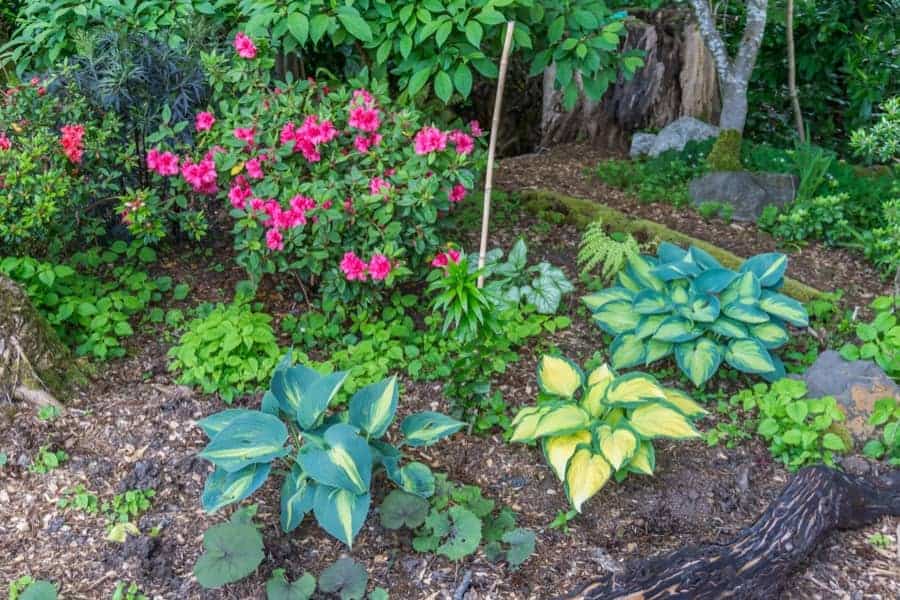
Hostas planted in the right environment continue to flourish for many years with less maintenance. But what does the ‘right environment’ means? Do hostas like partial shade or full shade? Can they tolerate full sun?
Most Hostas are best planted in areas that receive morning sun with afternoon shade. However, depending on the variety, the sunlight requirements for these perennials may vary. Such as, Hostas with light color foliage need a fair amount of sun exposure so they do well in partial shade, whereas, dark-leafed Hostas prefer complete shade.
If you are planning to add hostas to your garden, this article is for you. Here we have covered various aspects of planting hostas, such as optimal sunlight conditions and some care tips to help you along the way.
Where To Plant Hostas: In Sun or Shade?
Hostas are versatile perennials and come in 70 different species with over 2500 cultivars. Most hostas are shade lovers, but their sunlight requirements vary widely depending on the variety being cultivated.
Whether to plant a hosta in the shade or sun is best determined by its leaf color.
- Hostas with lighter foliage, such as yellow and gold-leafed plants, need the partial sun to develop their brightest coloration.
- Hostas with darker foliage, such as green, blue, and white-leafed plants, prefer to be in the shade as it helps them retain their leaf color for a long time.
- For variegated hostas, placements depend on the most highlighted leaf color, preferably the center coloring.
Most Hosta Varieties Prefer Shade
Ideally, all hostas need shade. Some are best grown in partial shade, while others require complete shade.
Even the most sun-tolerant hostas require only four to six hours of sunlight to thrive. However, many gardeners mistake ‘full sun’ hostas for ‘all day sun.’
No doubt, these varieties can tolerate more sun exposure than others. But, direct sunlight from noon to 4:00 p.m is too intense for most hostas to stand. Too much sun can dull the Hosta’s coloration and lead to leaf browning.
As a rule of thumb, morning sun with afternoon shade is probably the best placement for most varieties.
Care Tips: Shade Vs. Sun Hostas

Almost all shade and sun-tolerant hostas share the same principles, whether it’s ideal growing conditions or maintenance.
They only differ in placement – the most crucial part. Hostas with light coloring foliage are best-planted where they can receive morning sun and afternoon shade. For hostas with deeper, darker foliage, place them in shadier corners of your garden. Direct sun for long hours causes the leaf to lose its vibrant colors.
Following are some of the tips you must follow when dealing with Hostas:
- Rich organic soil with a slightly acidic pH allows hostas to thrive and flourish at their best.
- When Hostas are newly planted, keep their roots moist but not wet. Once rugged and established, they can adapt to various soil conditions and even tolerate summer drought.
- Drainage is crucial for cultivating Hostas.
- Crown rot and leaf rot should be your only concern when it comes to preventing Hostas from perennial diseases.
- You can divide mature Hostas if you want, but it’s not necessary for the plant’s health.
- Fertilize your hostas each spring with an all-purpose garden fertilizer for optimum results. Additional summer fertilizing can be helpful but not necessary.
- Unfortunately, hostas are favorites to deer. If your garden is prone to deer invasion, you can use scent deterrents or try planting daffodils around your hosta plants.
- For Hostas, too much sun followed by lack of watering leads to leaf scorch, especially in July and August. Sun-tolerant varieties can tolerate the heat, but that may affect the plant’s appearance making them unsightly.
- Hostas are less likely to compete for water and nutrients. Therefore, they are best planted away from trees and shrubs with greedy surface roots.
- Full sun hostas need to be watered regularly. Automatic drip irrigation comes in handy in most cases.
Recommendations for Sun Tolerant Hostas
Hostas with light coloration or thicker and more textured leaves do best in full-sun sections of the yard.
Following are some of the popular Hosta varieties that thrive in the sun:
- Fragrant Hostas – Sugar & Cream, Summer Fragrance, and Honeybells
- Green Hostas – Pearl Lake and Invincible
- Yellow Hostas – August Moon and Rising Sun
- Yellow variegated Hostas – Gold Standard and Sundance
- White variegated Hostas – Patriot and Francee
Types of Shade – Light, Partial, Full, Dense
Shade is defined by the varying degrees of relief from the sun. Here are the different levels of shade, ranging from light to dense.
Light Shade:
During summer, areas that receive direct sunlight between three and five hours each day fall into the light shade category. These locations are best suited for sun-tolerant Hostas. Shade-loving varieties will also do fine, as long as they receive sun in the morning hours when it’s less intense than in the afternoon.
Partial Shade:
Garden sections that receive two hours of direct sunlight or remain shaded for at least half the day are best for partial shade Hostas. However, depending on the morning or afternoon sun can make a big difference to these ground covering perennials. Partial shade is easily found around trees and light reflections from nearby buildings.
Full Shade:
These areas in your yard barely get an hour of direct sunlight each day. Dappled light coming through the gaps in a tree canopy is considered full shade, even if it’s for most of the day. Complete shade hosta variety will do great here.
This type of shade is often created by trees, buildings, fences, and other solid structures that block direct sunlight and overshadow the areas.
Dense Shade:
No direct or even indirect sunlight reaches the ground in densely shaded areas. Only the plants with no sunlight requirements grow here. Feel free to plant shade-loving hostas if you have such spots in your garden. This way, you will be able to utilize empty spaces in your yard with stunning perennials that require little care and maintenance.
Related Questions
Q. How to choose the best shade-loving Hostas?
Hostas with darker foliage, such as green, blue, and variegated hostas, are best suitable for shaded areas around bushes and trees.
Q. What is the best soil condition for growing Hostas?
As long as your garden soil is moisture-rich, fertile, and full of organic matter, any variety of hosta will flourish in it.
Q. Do Hostas grow well under trees?
You can plant Hostas under or around trees but make sure to maintain some gap between them. Competitive tree roots may deplete Hostas of basic nutrition and water requirement.
Final Words
Most Hostas, including the commonly available varieties at your local garden center, will do just fine in partial to full shaded environments. Based on varieties, especially leaf coloration and thickness, hostas are best placed in any garden.
